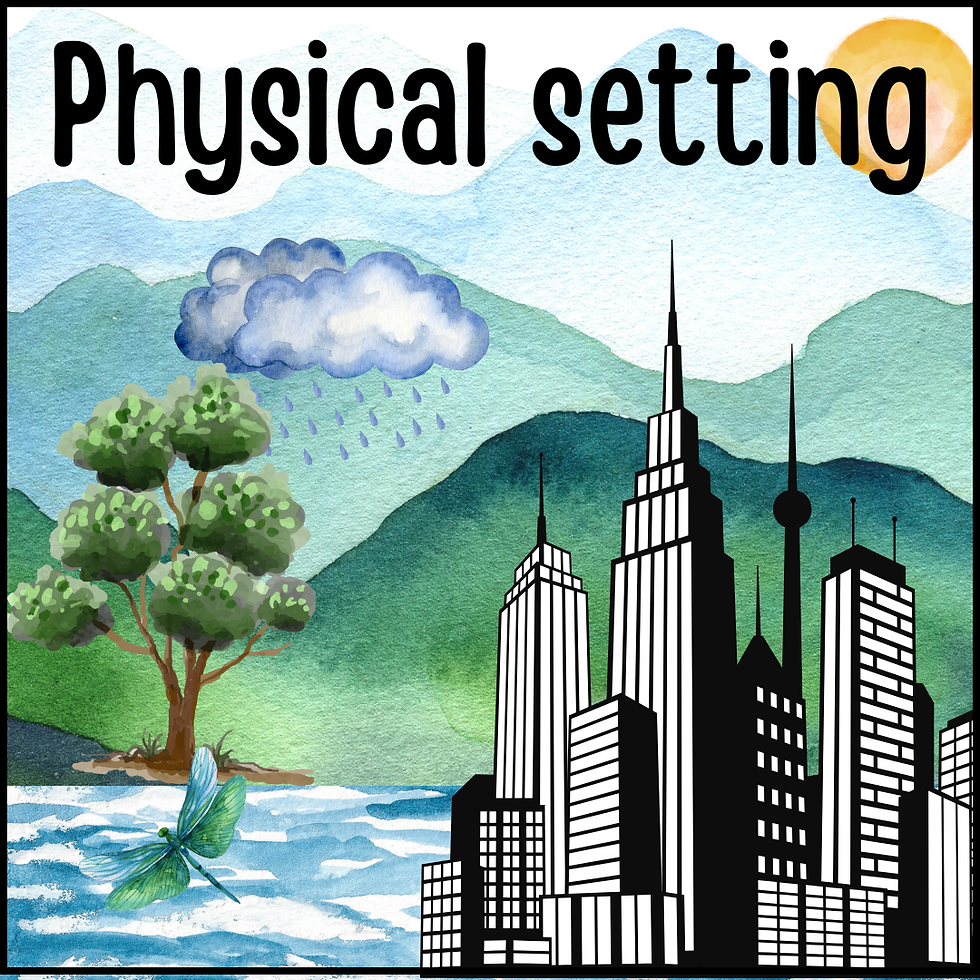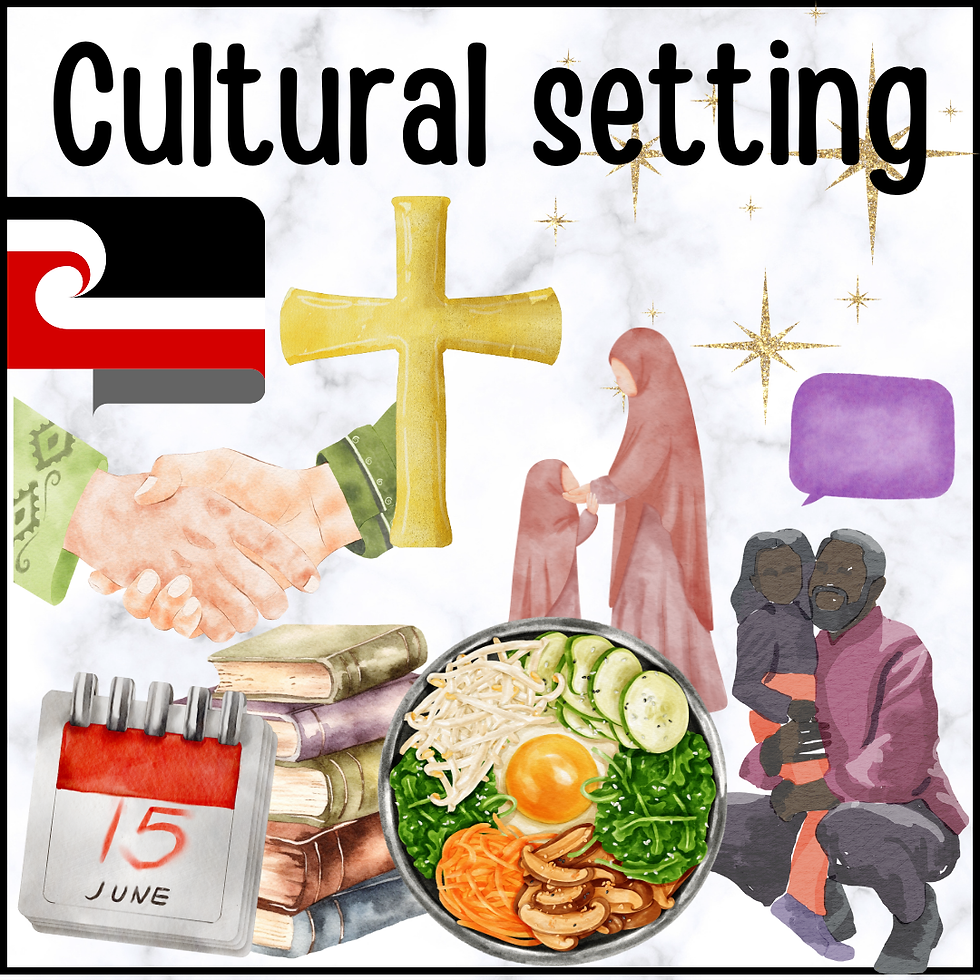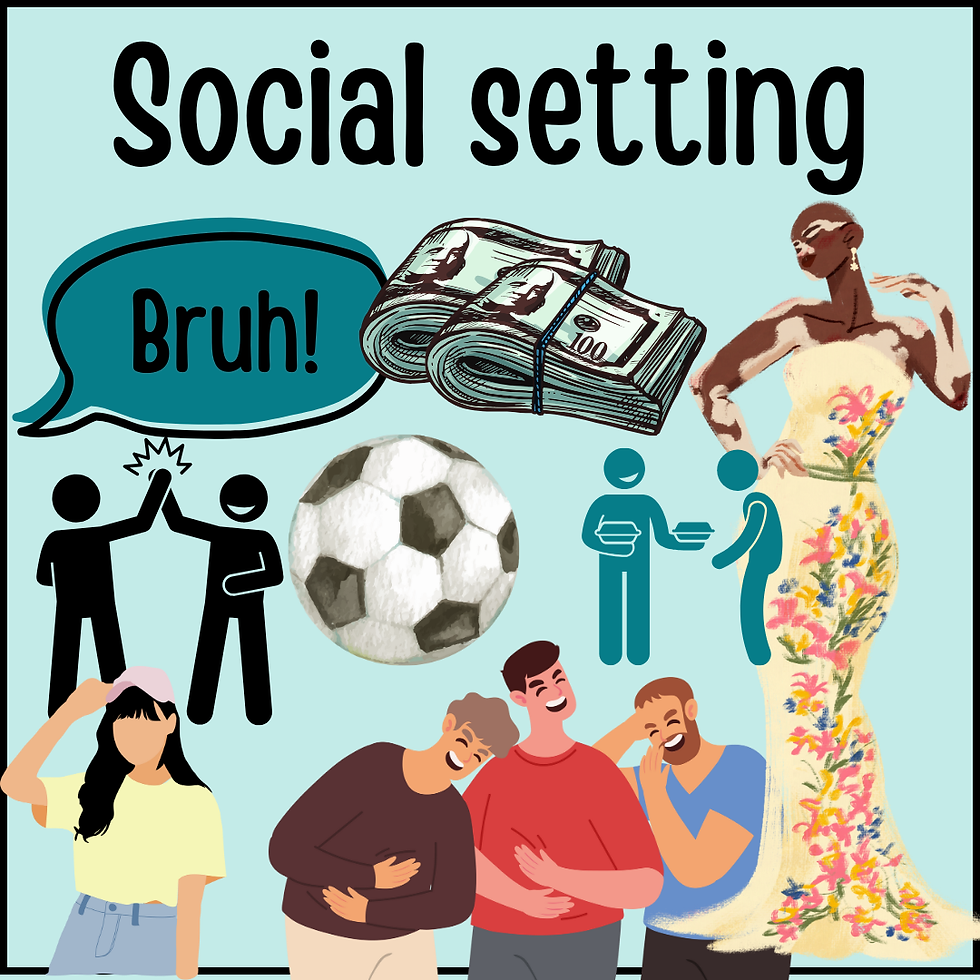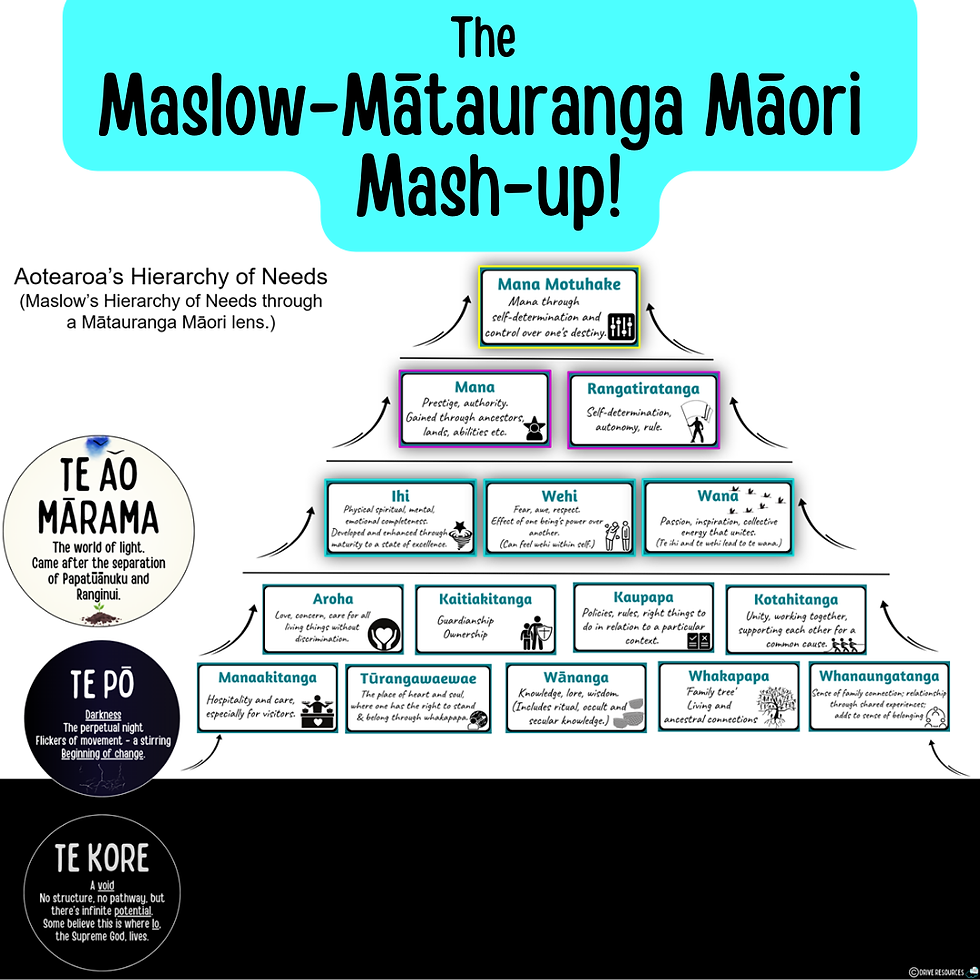Setting is BOSS! Teaching students about setting
- Sue de Lautour

- Jun 6, 2024
- 7 min read
Updated: Jun 10, 2024

The element of texts that gets most of the glory is ‘character’ where we focus on conflict, relationships, development. But in fact, setting is boss! Setting is the shiny thing! Let's discuss teaching students about setting.
Types of setting:
I like to focus on these 4 settings (though it depends on the level of the class):
Physical setting – this includes time (temporal setting) and place (spatial setting)
Political setting
Cultural setting
Social setting
These settings work together to influence people (characters) ... who in turn influence events. (Kiwi teachers: think NCEA 1.2 Aspects of Studied Texts!) I discuss each of them below.
The Lifespan of settings:
Before we get into each setting, here's something I hadn’t consciously thought about until recently. Settings 'kind of' have a lifespan. Senior students may benefit from appreciating the following:
Physical setting:
Time and place – this is predictable and constant.
The only way a place changes is when people change it.
Political setting:
Potentially changes overnight – a military coup, an election.
Changes are usually a rare and momentous event but something that features often in dystopian texts.
Cultural setting:
Culture is powerful and rigid. More on this below!
Social setting:
These undergo small but constant changes. They’re dependent on trends and the fickleness of that particular group.

Physical setting
Describing the physical setting:
Describing the time:
Era – eg: the depression between World Wars I and II, gold rush days, medieval times, the days of the Berlin wall, the Obama era, the iron age, the industrial era...
Gregorian/Christian (years, months, days) – eg: June of 2034...
You can also describe the time according to how you feel about it. For example, it’s ancient, it’s modern.
Describing the mood:
You can describe the mood of a physical setting. For example, it feels romantic, or it seems inspiring...or dismal.
Describing the place:
You can describe place according to what your senses (or a character’s senses) experience. That is what it looks like, sounds like, smells like, feels like (physically), and even tastes like.
Going all out – getting figurative:
You can also describe a place with figurative language. For example: this town is gangrenous. You wouldn’t mean that literally, but it certainly tells us a lot about the town! (Further below I discuss using proverbs (whakataukī and whakatauākī), which are often figurative, to help describe setting.)
Give students a list of words. Encourage them to find more.
Move into how the physical setting affects characters
Focus particularly on the main character (protagonist) and, if appropriate their valiant supporters.
For example, how do the mountains, the distance to travel, the heat etc:
Challenge the character(s)?
Force the character(s) to develop to overcome these challenges (knowledge, skills gained)?
Enable the character(s) to flourish? (The alternative and more positive angle!)

Political setting
How governments come to be and operate:
Often a mystery to students, sum this up with these four categories. Even junior students can understand this. I’d get students to rote learn these because they appear repeatedly in our literary studies.
· Autocracy – one absolute ruler (often a dictatorship, where rule is forced)
· Oligarchy – governed by the few (generally following their own agendas) – totalitarianism is usually the modus operandi!
· Democracy – the most popular party (and its leader are elected).
· Anarchy – no formal governance – but doesn’t necessarily mean chaos and tyranny! Consider, for example, how people/characters organise and govern themselves after a natural disaster or in times of war.
Note: many texts involve a small group operating, by necessity, alone. Eg: John Marsden’s Tomorrow When the War Began, Neal Shusterman’s Scythe series, Tayi Tibble’s “Everyone was there, e hoa”, gangs or street-kids with their own hierarchies and forms of justice… These are classic examples of anarchy – some working for the betterment of the people...the latter...mmmm.
Historical events impact on political setting:
Dig deep to consider the impact of historical events on political settings. These make a difference as to how characters perceive and react to leaders/governments.
Coups
Treaties
Wars
Deaths – assassinations in particular
The rise and impact of the corporate bully
Dishonourable events (associated with the leader or country)
Ritualistic tests of leaders (age-old traditions such as physical challenges/initiations)
Effect on characters:
In their study of a text, students can discuss the country’s government, or the system adopted by a break-away group. I think it’s important to acknowledge both as – think of the Divergent series – they’re usually completely different. Comparing the two would be a great activity to spark some critical thinking.
Consider also how this governance make life easier or harder for the characters. Answering this leads to discussion about character development.
Describing the political setting:
Again, give students a list of vocabulary to help them describe governance and the governed. They can describe the situation, but also the mood.

Cultural setting
The power of culture:
Emphasise the power of the cultural setting. You can’t change a culture. The incredible thing about culture is that it survives! Culture survives:
Natural disaster
Time – 200 years ago or into the future, your culture won’t change.
Political turmoil – the best/worst leaders, war…
Pockets of its own people who run in their own social settings and make up a few of their own ways.
Genocide. (I struggle to even type that word.)
What is culture?
To help students understand what a culture is, first get them to describe their own. Some students might argue they ‘don’t have a culture’ but that’s because they’re in it. Ask them to view how they live from the perspective of a person from a different culture entirely. An easy way to get them thinking is to ask students how people from different cultures treat death, marriage, women, religion.
Describing and explaining the cultural setting:
Again, give students a list of words to describe cultural settings - including the mood. Most importantly though, provide them with a list of things to consider when describing a culture. Eg:
Language
Family
Food
Ceremonies and celebrations
Protocols/Tikanga
Time – it’s measurement and use
Other/higher worlds – gods, stars
How people are valued – gender, children, sexuality
Relationship with place (how does this place nourish, provide a sense of belonging, build mana – tūrangawaewae)
Meetings – how these are conducted
Symbols and objects
Histories and shared experiences (whanaungatanga is as strong as any blood tie)
Ancestral influences
Class systems/hierarchies
Knowledge
Health
Naturally, from here you can progress into how cultural setting affects characters - their actions and reactions. And these, as we know, affect events.

Social setting
Weirdly, this is often the most difficult setting for students to understand. It's weird because it's ironic! I mean think of the weight they give to their ‘friend group’ – that school lunch table is a social setting! Bruh! The school, whether students like everyone or not, is a social setting. Their hockey match is a social setting. Nan’s card group is a social setting.
Think of social setting as a place where groups of like-minded people hang out. Groups might belong to the same culture, but each have their own wee eco-system.
Nan’s knitting group and the local army training unit might belong to the same culture, but each of those groups also has:
its own way of dressing
its own way of speaking (colloquialisms, jargon)
Its own values
its own way of behaving (tikanga), and
its own purpose (kaupapa)
shared experiences (whanaungatanga).
Other things to ask about a social setting could be:
What’s cool? What’s not?
What does mana (charisma) ‘look like’ in this setting?
What motivates this group?
How does this group define wealth?
How does this group define beauty?
As with the other three settings, from here you can progress into how social setting affects characters, and, in due course, events.
Conflict and Harmony (extension work)
To extend students, have them consider the similarities and differences between what I call the ‘people’ settings: political, cultural and social settings.
Consider things like the values, needs and wants associated with each of these and show this in a Venn diagram.

You’ll notice that:
Where aspects of one setting stand alone, there is potential for conflict.
Where there are similar values, harmony is more likely to eventuate.
Linking beyond
Gods and stars
Have students think about the part gods or stars might play in the settings of a studied text. How might they be valued here? How might they be influential here? For example:
Perhaps Tūmatauenga, God of war, has had a hand in the political setting of your text!
How might Tāne Mahuta, God of the forest, at work here?
Pōhutukawa (star of Matariki) might be significant here if there are people lost and mourned in your text.
Proverbs
Get figurative with proverbs – what whakataukī (origins unknown) and whakatauākī (origins known) could be used to help describe or explain the place, mood or values in your class’s studied text?
Maslow’s Hierarchy of Needs
I love me a good ‘Maslow’ lesson! Introduce your students to Maslow’s Hierarchy of Needs (they’ll love it). Have them think about how the/a setting in the text they’ve studied fulfils each layer of need.
Kiwi teachers – check out the Maslow-Mātauranga Māori mash-up where I look at how we can reach our pinnacle – moving from Te Pō (the world of darkness) into Te Ao Mārama (the world of light) and beyond through key values in te ao Māori. That is, an Aotearoa version of Maslow's Hierarchy of Needs!

Explore this with your students in the following resources:
Pick up a free copy of the Maslow-Mātauranga Māori mash-up here.
The effects of setting on character
I’ve mentioned the effects of each of the setting on characters throughout this post. Ultimately, students must understand that all four aspects of setting (physical, political, cultural and social) affect characters. These effects result in the development of that character as they adapt to or change in order to survive and flourish. Encourage students to consider how setting affects:
How the character feels
Relationships the character has
Decisions the character makes
Knowledge and skills acquired by the character
Effect of setting on events
Setting influences characters – their actions and reactions – which in turn affect events. A good way for students to explore this is to give them the chance to reflect and hypothesise with:
· If [character] hadn’t… then…
· Because [character]… then…
Encourage students to understand that events, while driven by the character, were ultimately influenced by the physical, political, cultural and/or social setting.
Setting is everything!

.png)









Kommentare